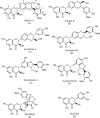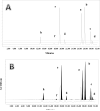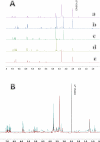Silybum marianum pericarp yields enhanced silymarin products
- PMID: 27233988
- PMCID: PMC4939139
- DOI: 10.1016/j.fitote.2016.05.012
Silybum marianum pericarp yields enhanced silymarin products
Abstract
An improved method for the purification of silymarin, the flavonolignan complex from the fruits of milk thistle, Silybum marianum, is reported. The method enables a more efficient extraction of silymarin from the pericarp after it has been separated mechanically from the rest of the fruits. Accelerated solvent extraction (ASE) was employed for each extraction procedure. Quantitation of the eight major silymarin components in the pericarp extract was compared to that of the whole fruit extract using two orthogonal analytical methods. The pericarp extract showed higher silymarin content (2.24-fold by HPLC and 2.12-fold by qHNMR) than whole fruit extract using acetone as an extraction solvent following defatting with hexane. Furthermore, the mg/g recovery of silymarin major components was not diminished by eliminating the hexane defatting step from the pericarp extraction procedure. The efficiencies of acetone, ethanol, and methanol as extraction solvents were compared. Methanol pericarp extract showed the highest content of the silymarin major components, 2.72-fold higher than an extract prepared from the whole fruits using acetone. Finally, all of the major silymarin components showed a higher w/w content in the pericarp extract than in a commercial extract.
Keywords: Accelerated solvent extraction; Pericarp; Silybum marianum; Silymarin.
Copyright © 2016 Elsevier B.V. All rights reserved.
Figures






References
-
- Boulos L. Flora of Egypt, Volume three (Verbenaceae - Compositae) Al Hadara Publishing; Cairo, Egypt: 2002. pp. 157–159.
-
- Flora K, Hahn M, Rosen H, Benner K. Milk thistle (Silybum marianum) for the therapy of liver disease. Am. J. Gastroenterol. 1998;93:139–143. - PubMed
-
- Singh RP, Tyagi AK, Zhao J, Agarwal R. Silymarin inhibits growth and causes regression of established skin tumors in SENCAR mice via modulation of mitogen-activated protein kinases and induction of apoptosis. Carcinogenesis. 2002;23:499–510. - PubMed
-
- Smith T, Lynch ME, Johnson J, Kawa K, Bauman H, Blumenthal M. Herbal dietary supplement sales in US increase 6.8% in 2014. HerbalGram. 2015;107:52–59.
-
- AbouZid S, Ahmed OM. Silymarin flavonolignans: structure-activity relationship and biosynthesis. Stud. Nat. Prod. Chem. 2013;40:469–484.
Publication types
MeSH terms
Substances
Grants and funding
LinkOut - more resources
Full Text Sources
Other Literature Sources

